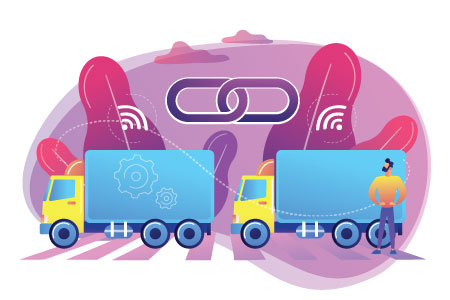
Truck platooning is the linking of two or more trucks in convoy using connectivity technology and automated driving support systems. The trucks maintain a set distance between each other. The lead truck sets the pace and the truck behind reacts and adapts to changes in the lead truck’s movements.
Peloton, one of several companies developing platooning technology, grounds their system in best-in-class safety technology. Their focus is to make each truck safer at all times by requiring collision avoidance and lane departure warning systems, air disc brakes, electronic stability control, continuous safety monitoring and predictive maintenance. Added to this are vehicle-to-cloud connectivity and vehicle-to-vehicle communications.
Platoons in the program are limited to two trucks with a driver in each truck who is steering and in command at all times. They share a dedicated radio link and real-time video. Each driver can see the blind spots of the other’s truck and look out for each other.
A close, safe following distance is automatically maintained as the lead driver is accelerating and braking for both trucks. Reaction time is reduced to a tenth of a second compared to a driver’s reaction time of two seconds. The trucks are ordered by braking ability, with the longer stopping distance placed in the lead reducing the chance of a rear-end collision within the platoon.
The operations cloud limits platooning to multi-lane, divided, limited-access highways during moderate to low traffic conditions. Platooning is discontinued during bad weather conditions, steep grades and construction zones, along with other specialized areas such as lower capacity bridges.
“In our initial operations with very large customers, we have seen excellent fuel savings, high utilization and a perfect safety record,” Peloton CEO Josh Switkes said. “Over the last five years, as we have developed platooning to commercial readiness, we have found that to get the benefits our customers seek, the system must combine the right functionalities around Vehicle-to-Vehicle (V2V) communication, cloud supervision and coordination, and the right driver experience.”
Real-world use of the system has resulted in improved fuel savings, safety and fleet management. The verified combined fuel savings of 7.25 percent was achieved at a 40 foot following distance at 65 mph. The payback for typical regional or long-haul trucks was less than one year. Fleets also were safer, and obtained high-quality data and improved analytics.
Varying state regulations have an impact on the viability of platooning. While no states have enacted bans against platooning, current laws were written before this technology was conceived. The regulations most in the spotlight are following-distance laws. Twenty-four states specify a minimum gap; 26 mandate a “reasonable and prudent” distance between vehicles.
Among the states with a minimum gap, several have updated their laws to allow platooning. Seventeen states with a mix of regulations have passed laws that specifically allow platooning.
“Working together, you’re able to handle the road better. These are significant driver teamwork, driver empowerment tools, and we’re excited about them.”
Steve Boyd, Vice President of External Affairs, Peloton